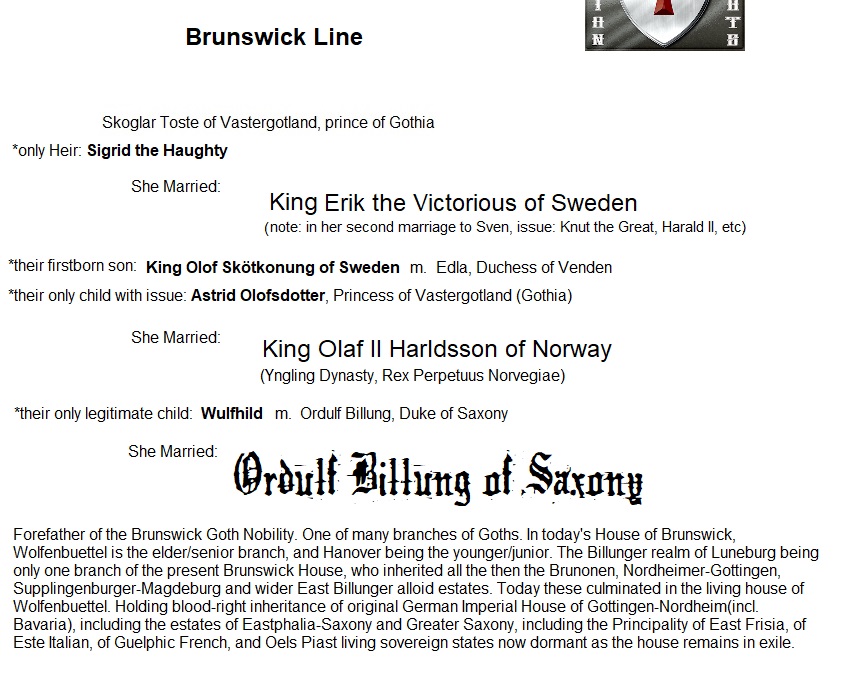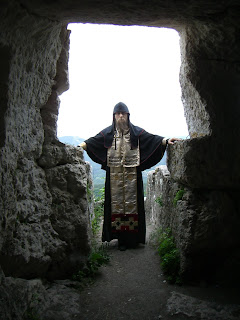The House of Wolfenbuttel-Brunswick Being a Legal Successor to Numerous States of the Goths’ Empire.
ЗМІСТ
- НАСЛЯДНИКИ МІНІАНТІВ, ЯК ГЕРЦІВ І ІМПЕРАТОРІВ САКСОНСЬКОЇ НІМЕЧЧИНИ (КОРОЛЕВИЙ ДІМ ОСТРОГОТ)
- GUELPH LINE OF OSTROGOTH HEIRSHIP
- ESTE LINE OF OSTROGOTH HEIRSHIP
- НАЗВАННЯ КНЯЗЯ ГУТІНГІ (ГОТТИНГЕН) СТАЛ БУДИНОМ НАЗВО ДОМУ ЕСТ-ГВЕЛЬФА БРЮНСВІК
- НАСЛІДК КОРОЛЕВСТВА ГОТІЇ В ТРАУЛЬНИХ ЗЕМЛЯХ ІСПАНІЇ ТА ФРАНЦІЇ (ЗАРАЗ ЛАНГУДОК)
- TOULOSE VISIGOTH HEIRSHIP. MULTIPLE LINES OF GOTHS’ STATE SUCCESSORS WERE UNITED IN OTTO IV, THE DUKE OF BRUNSWICK, WHO WAS CROWNED EMPEROR OF THE HOLY ROMAN EMPIRE
- МАЙКА ВСІХ ФРАНЦУЗЬКИХ КРАЛІВ, АРГОТТА І РАННЯ ГІЛЬФАНІЯ (БРЮНСВІКСЬКА СТАРША ФІЛІЯ)
- ШВЕЦЬКО-ДАНСЬКИЙ ДІМ ГОТІЇ
- НАСЛІДЖЕННЯ ГОТІЇ І ІМПЕРСАЛЬНЕ НАСЛЯДЖЕННЯ
- YNGLING-GOTH DYNASTIC HEIRS
- ПОСТІЙНИЙ ЗАХИСТ КРИМСЬКОЇ ГОТІЇ
- KIEV-RUS GOTH DYNASTIC HEIRSHIP
- ROYALTY OF HUNGARIAN GOTH ESTATES, AS PIAST & POLAND-LITHUANIAN SUCCESSORS
- HISTORICAL AND NEW DYNASTIC CHARTS OF THE HOUSE OF WOLFENBUTTEL-BRUNSWICK
- PRINCE STEPHEN, ANOINTED AS A KING(of one jurisdiction) OF THE GOTHS FOR THE AOCC ARCHDIOCESE OF BERLIN, CONSECRATION CEREMONY IN 2015
- DNA Match of the Royal Capetian Line of Nott-Brunswick
НАСЛІДНИКИ МІНІАНТІВ
Сьогодні найвідоміша сім'я наступників Будинку Смуги (leading dynasty of the Goths), the Royal House of the Ostrogoths of Italy, is most widely known as the Billungs. This house will be demonstrated in addition to a few other kindred houses which have held and continue to hold these estates. The primogeniture family successors of these Gothian houses is demonstrated herein. It is a long established fact of history as being realized in the House of Este-Guelph (head Dynastic Branch being Princes of Wolfenbuettel). The genealogy of the Billung’s successors are found below.

У 1137 році контроль над Саксонією перейшов до династії Гвельфів, нащадків Вульфільда Біллунга, старшої дочки останнього герцога Біллунга, імператора Лотара III Супплінбурзького. Що перейшло до його імператорського наступника Генріха Гордого, до Генріха Лева Брансвікського та його сина імператора Оттона IV Брансвікського. Брансвік - це найстаріший в Європі Королівський (та імператорський) дім у міжнародному праві (хоча де-юре та засланий, Брансвік-Вольфенбюттель діє в міжнародному законодавчому праві).
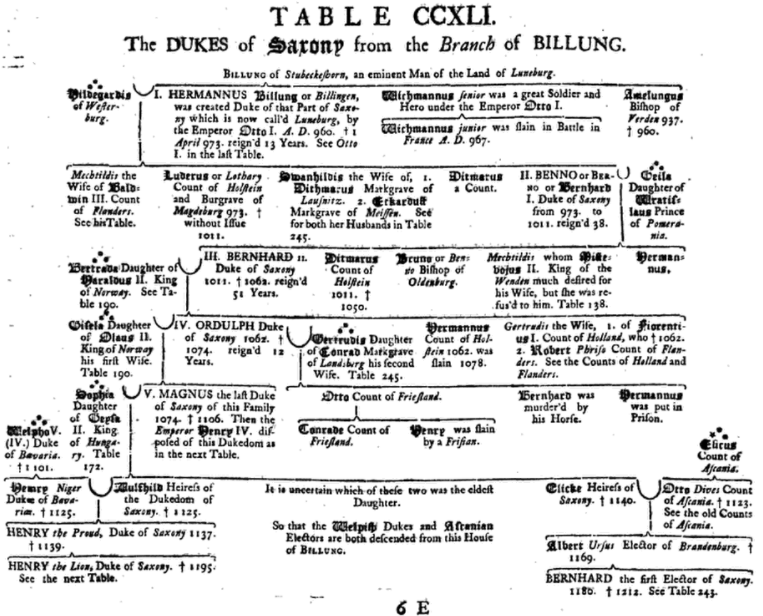
Германн Біллунг із Саксонії - прямий наступник чоловіків Хенгіста, Вітукінда та Готі.
 З часів Генгіста, Саксонії, короля Кента, його син Еск був королем Кента, а також його син Охта і його син Еорменрік, і його син Сент-Етельберт I, і його син Етельберт, і його син Едбальд , а його син Еорменред із Саксонії - усі були королями Кента Англії. У нього був син Етельберхт, який залишився лордом у Саксонії, а його син також граф у Саксонії, Біллунг фон Венден, згідно з одним повідомленням. В інших відомостях Етельберт II був королем Кента, сини повернулися в Саксонію, відому як Біллінгс (Billungs) Саксонії. Більшість генеалогій сягають, принаймні, “Брунхарта Біллунга І. фон Стубенскорна Графа в Заксені”, графом Тюрінги був син Етельберт. Брат цього Бруно I був Амелунг I Біллунг, (рядки якого задокументовані аж до 1137 року, коли вони вимерли, а їхня остання спадкоємиця вийшла заміж за спадкоємця чоловіка д'Есте-Гельфа (Брансвіка). Біллінгс контролював Нортмарк під керівництвом Вічмана Старшого. Наша головна філія Біллунгів контролювала Північний Біллунгерський марш. У поєднанні це була величезна територія. Амелунг I породив Беніда І Біллунга, який породив Амелунга II Біллунга, який породив Амелунга III Біллунга, який не зміг виростити спадкоємців у 9го століття. Потім лінія продовжувалась через Бруно, як показано нижче, до Генріха Лева (Лева) з Брансвіка та його сина імператора Отто IV фон Брансвіка та живих правонаступників сьогодні.
З часів Генгіста, Саксонії, короля Кента, його син Еск був королем Кента, а також його син Охта і його син Еорменрік, і його син Сент-Етельберт I, і його син Етельберт, і його син Едбальд , а його син Еорменред із Саксонії - усі були королями Кента Англії. У нього був син Етельберхт, який залишився лордом у Саксонії, а його син також граф у Саксонії, Біллунг фон Венден, згідно з одним повідомленням. В інших відомостях Етельберт II був королем Кента, сини повернулися в Саксонію, відому як Біллінгс (Billungs) Саксонії. Більшість генеалогій сягають, принаймні, “Брунхарта Біллунга І. фон Стубенскорна Графа в Заксені”, графом Тюрінги був син Етельберт. Брат цього Бруно I був Амелунг I Біллунг, (рядки якого задокументовані аж до 1137 року, коли вони вимерли, а їхня остання спадкоємиця вийшла заміж за спадкоємця чоловіка д'Есте-Гельфа (Брансвіка). Біллінгс контролював Нортмарк під керівництвом Вічмана Старшого. Наша головна філія Біллунгів контролювала Північний Біллунгерський марш. У поєднанні це була величезна територія. Амелунг I породив Беніда І Біллунга, який породив Амелунга II Біллунга, який породив Амелунга III Біллунга, який не зміг виростити спадкоємців у 9го століття. Потім лінія продовжувалась через Бруно, як показано нижче, до Генріха Лева (Лева) з Брансвіка та його сина імператора Отто IV фон Брансвіка та живих правонаступників сьогодні.
Герб Брансвік Вельфен (близько 1200) з могили Вельфса VI. та Welfs VII. в баптистському святому Йоганнесі (Штайнгаден); спочатку: блакитний лев на золотому фоні (сьогодні в Баварському національному музеї, Мюнхен). Helmzier, два роги буйволів, прикрашені павиним пір’ям, передавались вельфену в Брауншвейгу з 1290 року, і згодом вони стануть сьогоднішніми серпами. На гербі панів з Равенсбурга (Байенбурга) на гербі Цюріха, які були на службі у вельфа Генріха Лева, зображено як лева (стоячи), так і роги буйволів, прикрашені павиним пір’ям.
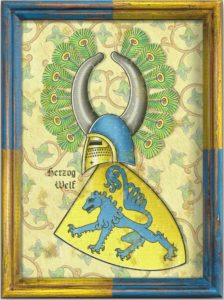
Нижче наведені основні алоїди (спадкові маєтки), перелічені як їх генеалогічна спадщина аж до основних ліній сьогодні в Брансвік-Вольфенбюттеле. Це показано разом із князівством Геттінген, що проходить вниз (включаючи Саксонію через Генріха Лева тощо).
(Note: 1. Gottingen was spelled Swedish Gutingi in the oldest documents. 2. The Gottingen alloid being from Woden-born Emperor Witekind (Saxony Dynasty) to his wife Geva, the daughter of the Haithabu King Gotterick of Denmark, the King of the primary realm called Gothia at that time in Scandinavia.)

На лінії Бруноїдів ви можете побачити, як це сталося з предком Брансвіка імператором Лотереєм та іншими саксонськими імператорами сім'ї.
Бруноїди також були герцогами Фрізії. Їх царство того часу (близько 900 р. Н. Е.) Використовувало руни на своїх монетах старшої версії Elder Futhark. Ось одна монета того періоду:
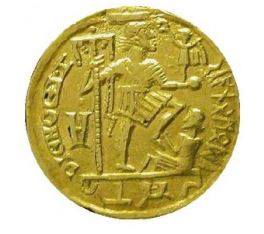
Більше про саксонські німецькі руни можна знайти за адресою: http://orthodoxchurch.nl/2020/04/hundreds-of-older-german-runes-demonstrate-the-scythian-goth-kinship-in-viking-and-saxon-nations-directly-linked-to-wolfenbuettel-brunswick/
Діаграма будинку:
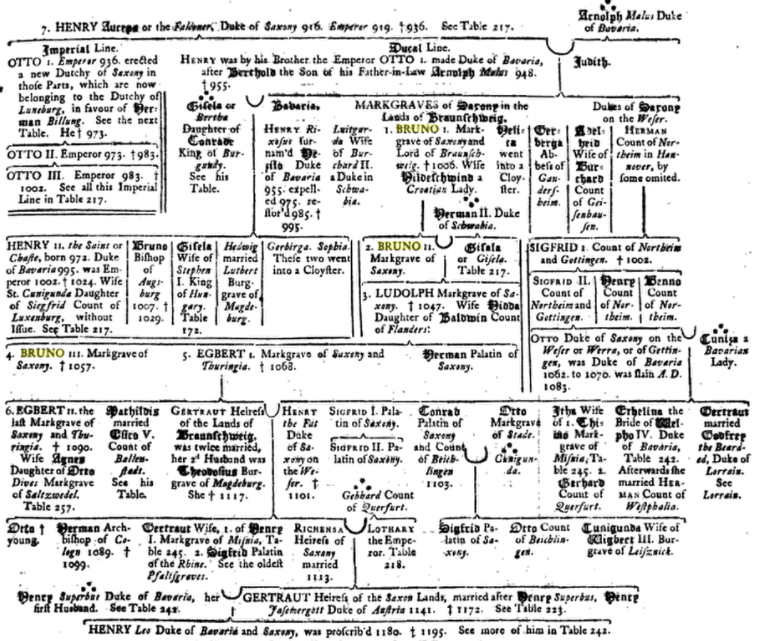
Як ви можете бачити (вище), у генеалогічних картах Батлера Геттінген також є взаємозамінним із Саксонією на Везері, а також з Нордхаймом.
| Billunger Imperial Dynasty (Kings of Vendi, Dukes of Billunger March, Nordmark and Ostmark, Dukes of all Saxony, Emperors) |
| Wislaus III, first King of the Vendi (Vandals) and Oborites. (father of 14 successive Kings of the Wends) at the Baltic. |
| Aribert I, second King of the Vendi (Vandals) and Oborites Father of King Aribert II, King of the Wends. |
| Brunhart Billung I. von Stubenskorn Count in Saxony, Woden-born, Count of Thuringa, Prince of Kent. Was second-born son of Aribert. |
| Billung von Wenden, brother of Amelung, princeps militiae, Duke of Saxony |
| Amelung III Billung, Marshal of Saxony, Duke Luneburg / Billunger March |
| Ordulf Billung, Duke of N E Saxony (Billunger March Pomerania / Poland region) + Wulfhild of Gothia, Sweden and Norway |
| Wulfhild Billunger of Saxony. Eldest dau of Magnus, Heiress of the Dukedom Saxony + Elector Henry the Black d’Este-Guelph, Duke of Bavaria |
| Emperor Henry the Proud of Brunswick, inherited senior male estates of Guelph and ruled from the Baltic to Sicily. His duchy of Saxony alone was larger than half of Germany. The pope cancelled his Imperial election for Conrad. |
| Henry the Lion of Brunswick, Heir of all Imperial estates at 10 years old. Fully occupied Wends lands and took control. Henry’s daughter Mechtild married the senior king of the Wends, to give back some Wends lands to form the Mecklenburg house. |
| Emperor Otto IV, Duke of Brunswick, King of Germany, Crowned Holy Roman Emperor |
| Otto the Child, successor of Brunswick, in Denmark was made count of Garding and Thetesbüll in Schleswig Holstein as a Danish prince through his mother Helena Regent, princess and duchess + Ascanian Mechtild/Matilda of Brandenburg, of the Billunger line via Elicke, the younger dau of Magnus Billung and the Ascanian Counts |
| Emperor Frederick I Duke of Wolfenbüttel-Brunswick, Crowned King of Germany, Holy Roman Emperor, he and his brothers re-took Brandenburg per the Billunger and Ascanian rights |
| Duke August the Younger, although was last in line of succession to Wolfenbüttel -Brunswick because his mother Ursula was Ascanian dau of Duke Francis I of Saxe-Lauenburg + Elisabeth Sophie of Mecklenburg(Vendi) whose heir Ferdinand Albert received the seconditure of Bevern- Wolfenbüttel |
| Wolfenbüttel Mini-Emperors. The ‘elder-branch’ Successors continually Emperors of states across the continent with continued Military rank higher than Emperor as Commander-in-Chief of Prussia, Austria, Poland, France, Senior branch over Hanover etc. Cont’d claim of estates linked with the “greater domains”. |
GUELPH LINE OF OSTROGOTH HEIRSHIP
| Guelph Imperial Dynasty
(Princes of Scyrii, Kings of Italy, of Burgundy, and of Lombardia, Counts of Genoa, incl Genovese Crimean Gothia, and Altdorf in Swabia, Margraves of Milan, Dukes of Bavaria, Carinthia, and other Italian Ostrogothic estates) |
| Pharamond, King of Sicambrian Franks + Princess Argotta dau of Emperor Theodoric of Gothia and Italy |
| Edico, King of the Scyri, Herulii and Rugii, father of Odoacre |
| Arnoldus, of Franks, G.father of Charlemagne & Carolingian Emperors |
| Ruthardus of Altdorf, father of Guelph I of Bavaria |
| Adalbert III di Lucca (Margrave) of Tuscany |
| Gerberga of Burgundy, ancestress of Hohenstaufen, her mother was 6th G granddaughter of Charlemagne, father was Guelph Conrad King of Burgundy |
| Cunigunda, Heiress dau of Guelph II + Azo II of Mlian, became Marquess of Este 11K mansi of land of Elisina Lombardy + Azo Prince of Este |
| Guelph III, brother of Cunigunda Duke of Carinthia and Marqis of Verona incl Tyrol & Rhoetian Alps |
| Rudolf II, Count of Altorf and Ravensburg. (Some Pre-Charlemagne alloidial estates) |
| Guelph IV Duke of Bavaria, sone of Azzo II and Cunigunda of Altorf Swabian Elder line of Guelph |
| Guelph V + Mathilda Este heiress of all estates. Passed to his Elder brother, Henry the Black of Brunswick |
| Guelph VI, younger bro of Henry the Proud, retained Altorf and Ravensburg, passing to sister Judith and husband Hohenstaufen Emperor Fredrick and jealous sons the rival Emperors |
| Henry the Lion of Brunswick, Heir of all Imperial estates at 10 years old. Although occupied, his sons repossessed all estates. |
| Emperor Otto IV von Brunswick |
| Emperor Frederick I Duke of Wolfenbüttel-Brunswick, Crowned King of Germany, Holy Roman Emperor |
| Wolfenbüttel Mini-Emperors. The ‘elder-branch’ Successors continually Emperors of states across the continent with continued Military rank higher than Emperor as Commander-in-Chief of Prussia, Austria, Poland, France, Senior branch over Hanover etc. Cont’d claim of estates linked with the “greater domains”. |
ESTE LINE OF OSTROGOTH HEIRSHIP
| Este Imperial Dynasty, Senior branch (Eldest living Italian Royal line, H.R. princes of Italian estates. Today the Younger branch is continuing subordinate to Guelphic Chief Elder branch of the house) Descended from old Actius in the reign of Tarquinius Priscus, King of the Romans, whose offspring were senators, one of them, Marcus Actius (Attius), married Julia Major, sister of Julius Caesar, by whom begat Actia, 2й wife of Caius Octavius and mother of Augustus Caesar. |
| Cajus Actius, Prince of Este, 390AD Julian Este Imp House of Caesar, Biblical House of Philippians 4:22 KJV ” All the Saints salute you, chiefly they that are of Caesar’s household.” |
| | |
| Caius Actius II. Prince, or Lord of Este, 402 *This line of pedigree is an exact translation of the M.S. compiled by the late Count de Chambord, and in his hand- (and in Anderson’s Genealogies) |
| | |
| Comte de Chambord’s Table of Este. Bonifacius, of Este, Lord of Feltro, died 556 ; his son was Valerianus, of Este, Lord of Feltro, killed in battle 550 ; his son was Gundelhard, Prince of Este, Feltro, and Monfelice, major-domo of Dagobert, King of France, 636; his son was Heribert, Lord of Este, 694; |
| | |
| his son was Ernest, Lord of Este, killed 752; his son was Henry I., created by Charlemagne Prince of Tarvis and Markgrave of Este, he died 780 ; his son was Berengarius, Markgrave of Este and Lord of Tarvis, died 840 ; his son was Otto II., Markgrave of Este and Tarvis, died 898; |
| | |
| his son was Sigfried I(or Albertus / Obertus / Sigbertus)., Count of Este, Lord of Lucca and Parma, died 954 ; his son was Azo II., Count of Este, Margrave of Milan and Genoa, Lord of Placentia and Reggio, made Imperial Vicar by the Emperor Otto I., he married Kunigunde von Altdorf, dau of Welf III, and died 970; |
| | |
| his son was Theobald I., Markgrave of Ferrara and Verona, Count of Canossa, Lord of Lucca, Placentia, Parma, and Reggio ; his son was Hugh III., Markgrave of Este, Milan, Genoa, Tuscany, and Stadtholder of Italy ; died 1014; |
| | |
| his son was Azo IV., by some called Azo III., the Great, Markgrave of Este; his son Azo VI., Markgrave of Este, he died 1055 ; his uncle was Welpho V (Guelph V)., Duke of Bavaria and ancestor of the House of Brunswick (end quote of Comte de Chambord’s Table of Este.) and he married Matilda, the so-called heiress of all the Este (Italian) estates. |
| | |
| Oberto Albert Azzo II (son of Albert Azzo I), Comte de Luni(Toscane-Italie), Marquis de Ligurie(It) et Milan(It), Genova, et al. + Alde de Saxe, Imperial Princess of the Holy Roman Empire, dau of Otto II (Ottonian Dynasty) died 1097 |
| | |
| Immilla Irmengarde d’ORIATE, dau of Olderic-Manfred II, Comte de Vintmille(Liguria-Italy), Marquis of Turin etc, and Bertha Obertini of Milan+ Ekbert ler Billungen Brunoid de Brunswick, died 1078 |
| | |
| Gertrude of Brunswick, dau of Irmangarde and Ekbert,, of Imperial Brunoid Dynasty alloid of Brunswick and East Frisia. + Henri le Gras Comte de NORTHEIM, died 1117 |
| | |
| Bonifacius(Bonifazio I d’Este), Prince of Ferrara, Mantua, Lucca, Parma, Modena, Placentia, Regio, Pisa, Spoleto, Ancona, and Tuscany |
| | |
| Azzo IV, Duke of Milan, Prince of Este + Ferrara to Tuscany |
| | |
| Emperor Henry the Proud d’Este von Brunswick, Senior Branch of Este. The Younger branch went to Azzo d’Este VI (1170–1212) who became podestà of Mantua and Verona. |
| | |
| Henry the Lion of Brunswick, Heir of all Imperial estates at 10 years old. Although occupied, his sons repossessed all estates. |
| | |
| Emperor Otto IV, Duke of Brunswick, King of Germany, Crowned Holy Roman Emperor (re-occupied Tuscany and re-conquered all Italian estates to Sicily) |
| | |
| Emperor Frederick I Duke of Wolfenbüttel-Brunswick, Crowned King of Germany, Holy Roman Emperor |
| | |
| Wolfenbüttel Mini-Emperors. The ‘elder-branch’ Successors continually Emperors of states across the continent with continued Military rank higher than Emperor as Commander-in-Chief of Prussia, Austria, Poland, France, Senior branch over Hanover etc. Cont’d claim of estates linked with the “greater domains”. |
БРЮНСВІКСЬКА НАЗВА «КНЯЗЬ ГУТІНГІ / ГОТТИНГЕН»
Коли в будинку Брансвіка найголовніше використовувався титул «принц Гутінгі / Геттінгена», це було між правліннями двох імператорів Брансвіка, Оттона IV та імператора Фрідріха I фон Брансвіка [офіційні імператори HRE. Будучи нащадками саксонських імператорів, будинок мав найвищі права як Есте-Гвельф. Як і на початку воєн Гвельфа Гіббліна, Тамплієр проти Госпітальєра].
The line listed in several encyclopedias shows Witukind, King of Saxony married Geva, the daughter of King Gotterick (of Denmark-Sweden vaster-Gotland). The Scandinavian land over which he was King over was called Gothia. It was understood the Saxony house dowery included a land med after the Kingdom, in Saxony itself called Gottingen. This root line of Gottingen-Brunswick birthed several generations of Emperors of Germany which were also crowned Holy Roman Emperors, ruling as chief dukes of the House of Brunswick (including official heads of the realms of Eastphalia, Westphalia, East Friesland, Sicily, several Italian principalities, French Estates, Duchy of Bavaria, Duchy of Pomerania, in those times) which has continued in more continued successions maintained than any other house today.
The Ottonian and Gottingen, Brunoid Dynastic Heirship in the Dukes of Brunswick:
| Saxon Imperial Dynasty (E and W Saxony, Ottonian Elder branch) |
Saxon Imperial Dynasty (E and W Saxony, Göttingen Younger branch) |
| Emperor Witekind, King of the Saxons, Woden-born, Prince of Angles, Christian death in 807AD + Geva, dau of Goderic( Göttrick), Haithabu King of Denmark (Gothia) | Emperor Witekind, King of the Saxons, Woden-born, Prince of Angles, death in 807AD + Geva, dau of Goderic( Göttrick ), Haithabu King of Denmark (King of Gothia) |
| | | | |
| Wigebert, son of Wittikindus, his firstborn successor via Geva (daughter of King of Haithabu Denmark) + Sindacilla, dau of Ratbodus, King of Friesland | Wigebert, son of Wittikindus, his firstborn successor via Geva (daughter of King of Haithabu Denmark) + Sindacilla, dau of Ratbodus, King of Friesland |
| | | | |
| Bruno I, senior Duke of Saxony, firstborn of Wigebert using Goth/Viking Runic coins | Bruno I, senior Duke of Saxony, firstborn of Wigebert, Goth/Viking Runic coins |
| | | | |
| Bruno II, Firstborn senior Duke of Saxony and Frisia(mini-Empire), built the City of Braunschweig, kept court at Göttingen | Bruno II, firstborn senior Duke of Saxony and Frisia, built the City of Braunschweig, kept court at Göttingen |
| | | | |
| Emperor Henry I, the Fowler, son of Otto, the younger brother of Bruno II, was King of East Francia and Duke of Saxony. Senior Line of the Ottonian Dynasty of Kings and Emperors | Sigfrid I, Count of Northeim and Göttingen (Founded younger Branch as desdended of Henry the Duke of Bavaria, youngest son of Henry the Fowler) |
| | | | |
| Emperor Ott, eldest son of Henry the Fowler. He was father of Emperor Otto II + Byzantine Princess Theophanu, Empress & Regent of Otto III. All were Kings of Germany, Crowned Holy Roman Emperors |
Otto, Duke of Saxony on the Weser (or of “Old Saxony” Göttingen) Immedinger (Witukindischer) of Nordheim Duke of Bavaria |
| | | | |
| Emperor Otto III, called the Wonder of the World, son of Emperor Otto II and Theophanu of Byzantium. He was assassinated by a Roman Consul’s widow in 1003, and was without issue. | Emperor Henry II, Duke of Bavaria, Duke of Carinthia, King of Italy, King of Germany, HR Emperor. Kept his Imperial court at Göttingen where died. |
| | | | |
| Princess Itha, granddau of Otho I via Richildis. + Rudolf II d’Guelph Count of Altorf and Ravensburg. Ancestor of the Electors of Brandenburg (Pre-Charlemagne alloidial estates) | Henry of Northeim- Göttingen + heiress Gertrude of Imperial Brunoid Dynasty alloid of Brunswick and East Frisia. |
| | | | |
| Kunigunde d’Este Guelph of Altorf, joining estates of both houses. She’s an Ottonian descendant as a Great Great Niece of Emperor Henry II, and named after his wife Empress Cunigunde. He was Holy Roman Emperor, Duke of Bavaria, King & Queen of Germany and Italy, kept the government at Göttingen. | Richenza de NORTHEIM, dau of Gertrude and Henry, + Lothaire II de SUPPLIENBURG, Empereur Romain germanique, Duc de Saxe, Comte de Supplienbourg |
| | | | |
| Emperor Henry the Proud of Brunswick, Ruled the Baltic to Sicily | Holy Roman Emperor Lothar (II) III of Supplingenburg, Duke of Saxony, King of Germany. + Richenza of Northeim Göttingen Saxony, dau of Henry of Norheim and Gertrude of Brunswick. Emperor Lothaire Granted all Imperial properties to his son-in-law, successor, Henry the Proud. |
| | | | |
| Emperor Otto IV, Duke of Brunswick, King of Germany, Crowned Holy Roman Emperor | Gertraut of Brunswick and Supplingenburg Heiress of the Emperor + Emperor Henry the Proud, Duke of Bavaria and Saxony, 6го Saxon Duke raised to the rank of Emperor since Witukind, but Imperial election stopped by the pope. |
| | | | |
| Emperor Frederick I Duke of Wolfenbüttel-Brunswick, Crowned King of Germany, Holy Roman Emperor | Henry the Lion of Brunswick, Heir of all Imperial estates at 10 years old. Although occupied, his sons repossessed all estates. |
| | | | |
| Wolfenbüttel Mini-Emperors. The ‘elder-branch’ Successors continually Emperors of states across the continent with continued Military rank higher than Emperor as Commander-in-Chief of Prussia, Austria, Poland, France, Senior branch over Hanover etc. Cont’d claim of estates linked with the “greater domains”. | Emperor Otto IV, Duke of Brunswick, King of Germany, Crowned Holy Roman Emperor |
| | | |
| Emperor Frederick I Duke of Wolfenbüttel-Brunswick, Crowned King of Germany, Holy Roman Emperor | |
| | | |
| Wolfenbüttel Mini-Emperors. The ‘elder-branch’ Successors continually Emperors of states across the continent with continued Military rank higher than Emperor as Commander-in-Chief of Prussia, Austria, Poland, France, Senior branch over Hanover etc. Cont’d claim of estates linked with the “greater domains”. |
The House of Wolfenbuttel-Brunswick descends of both these lines. Also descends from several other Imperial Dynasties as the only successor, as claimed and maintained in international law in every generation.
Хоча Геттінген довгий час був алоідіальним володінням і капіталом будинку, ім'я маєтку «князь Геттінгенський» з'явилося лише в цей період, на честь наших предків-оттонських імператорів, які тримали там свій імператорський двір. В основному це були будинки Саксонії-Біллунг-Готи.
Князівство Нортхайм іноді називали таким самим, як "Геттінген", хоча останні науковці зазвичай розрізняють їх як два. Цей регіон також називали "Саксонією на Везері" безпосередньо перед тим, як його об'єднали з імператором Лотейром і віддали його зятю Генріху Гордого.
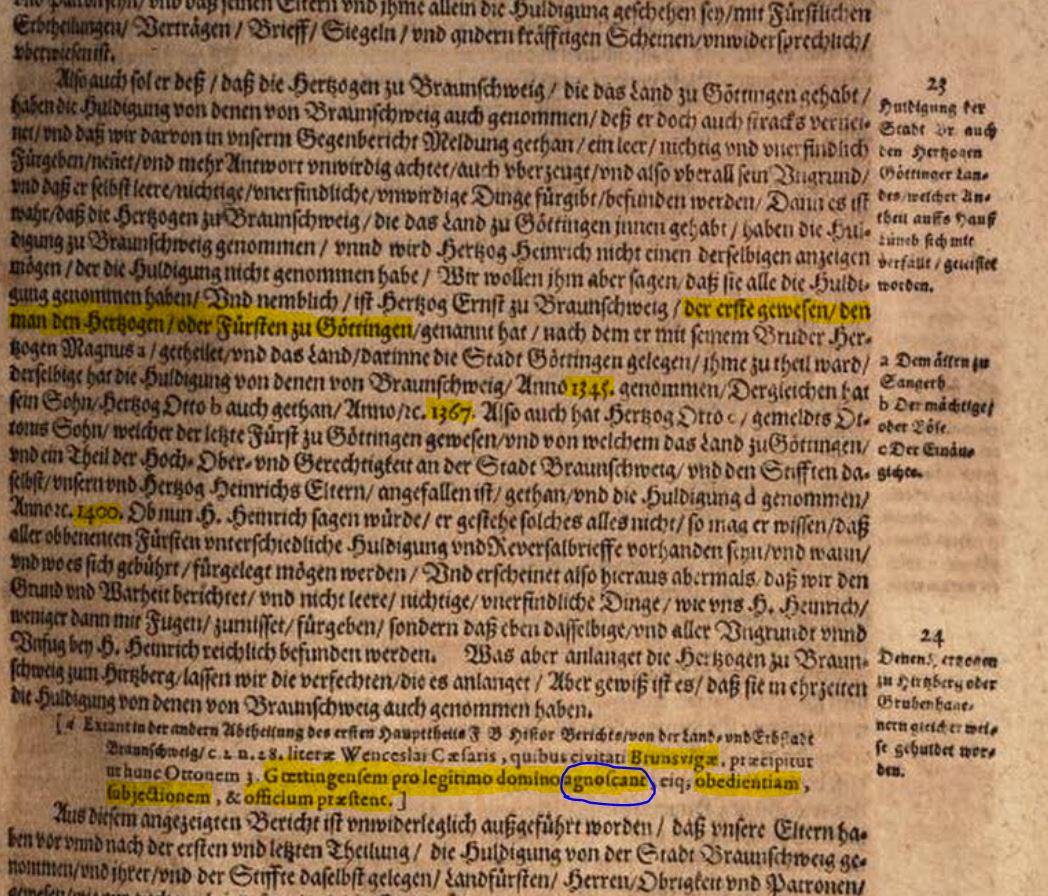
«Агнати» [нащадки кровних ліній] відтепер продовжували використовувати титул, зберігаючи право цього маєтку Імператорського палацу Гутінгі. Держава і сьогодні юридично є князівством, хоча лише в де-юре уряді в еміграції. Усі законні нащадки Брансвіка народжуються з титулом "принца Геттінгена", і лише головний герцог Брансвіка носить титул "Князь Геттінгена". Як спадкоємець найбільших частин спадщини Біллунг-Саксонія, цей імператорський палац у Геттінгені численних імператорів зробив відповідний алоїд для Брансвіка протягом більшої частини часу - для Палати.
Гербом Князівства Геттінген є головний герб Будинку Брансвік, як показано нижче:
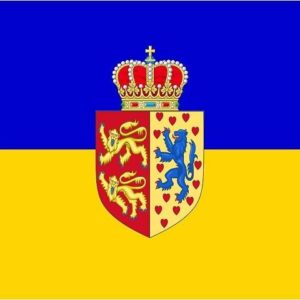 (Зверніть увагу на останню версію прапора Вольфенбюттель де-юре, яку він мав із білим та синім, а не із золотом. Однак золото використовувалось давно та взаємозамінно.)
(Зверніть увагу на останню версію прапора Вольфенбюттель де-юре, яку він мав із білим та синім, а не із золотом. Однак золото використовувалось давно та взаємозамінно.)
Капіталом для монархії Брансвік в першу чергу був Геттінген, інший час він був підпорядкованим вторинним капіталом деяких менших маєтків під більшою монархією Брансвіка. Стратегічно місто Брансвік деякий час було столицею, а також князівство Вольфенбюттель було деяким часом більш зручною столицею для Великого Брансвіка-Люнебурга. Більшість підпорядкованих князівств за останні 400 років визнавали своє підпорядкування, пишучи свої державні імена як Вольфенбюттель-Люнебург [наприклад], яке було ще одним князівством багатьох підпорядкованих князівств до лінії Вольфенбюттель головного старшого відділення дому, який царював над усіма як Абсолютний Монархи, який за визначенням також був самою мікроімперією, і залишився таким і сьогодні.
Імперські корони набагато ширші, про що можна прочитати, від Італії до Росії до останніх царюючих піастів, хоча всі вони легально вимерли як будинки. Проте все, що ми можемо сказати, наскільки завжди може продемонструвати наш стародавній і живий дім, все це походить від цієї центральної спадщини Гутінгі / Готи. Численні інші співоплемінні царства, котрі ми сьогодні возз’єднуємось!
More information on this living house is available from the Priory of Salem, Institute of Peace studies, if you write to the coadjutor at marshalofsalem@yahoo.com
НАСЛІДК КОРОЛЕВСТВА ГОТІЇ В ТРАУЛЬНИХ ЗЕМЛЯХ ІСПАНІЇ ТА ФРАНЦІЇ (ЗАРАЗ ЛАНГУДОК)
Багато рядків французької високої королівської спадщини Генріха Лева сходять до готів. Однією з них є лінія гвельфів, які походять від старшого батька Карла Великого. Однією з найвищих, можливо, є лінія Арготти, матері всіх французьких королів. Це офіційно частина французької історії, і тому ми включимо його у свій окремий розділ, пізніше.
Ім'я, територія та династія вестготів залишаються в титулах дворянства Франції. Франція (найвищі за рівнем князі) має декількох спадкових принців цієї сфери, використовуючи претензію як більшу провінцію під назвою «Лангедок». Прочитайте буклет Жана Лафіта та статтю під назвою «Лангедок, деформація * Земля Гот?». Династично це також демонстративно збережено (як я даю смак нижче). Родинна спадкоємність вестготів була збережена від первісної династії Бельців через вестготську принцесу Брунгільду, бабусю Пепіна (та інших вестготських дворян), передавши таким чином права франкам, пізніше династичним нащадкам, відомим як графи Тулузи та князі Готії. додаткові 800 років. Оригінальний царство землі Готія (вестгот) залишається в назві “Langeudoc” (Земля готів / Langue de Goth), згідно з численними автентичними записами, енциклопедіями тощо. Сьогодні ви також можете знайти його на будь-якій карті. Незалежно від того, чи називають вони свою територію Лангедок або Готія, різниці немає, оскільки всі сходяться на думці, що це одне й те саме місце, одне плем’я та просто інший правопис. Це було продовжено легально через жіночу генеалогію вестготів, також як титул "Готія", а пізніше в тому самому регіоні, що розмовно називається Лангедок. Більшу частину поколінь він залишався в уряді Тулузької знаті. Потім воно перейшло до їх спадкоємця Філіпа III, який був з попередньої династії Капетіан, і пройшов через усіх французьких королів до сьогодні. Ми знаємо, що Будинок Бурбонів, кадетська гілка династії Капетіанів, мав оригінальні гранти з назвою „Готія” згідно з загальноосвітніми книгами (одна, що додається на графіку). Первісна територія досягла французьких королів, спочатку перейшовши від вестготської принцеси Брунгільди. Вона передала його своїм спадкоємцям і королю Меровінгів Пепіну див .: https://gw.geneanet.org/belfast8?lang=en&p=brunhilda+of+toledo&n=germany . Як на зображенні, що додається, вся Готія законно (законно) пройшла династично від Бернарда I до його спадкоємців, аж до сьогоднішнього дня все конкретно. Не тільки королі захищали всі такі титули провінції, герцоги і графи також ніколи не відмовлялися від цієї юридичної особи, відомої як Лангедок, і не розпускали її жодним чином. Їхні претензії щодо цього славного порядного або відмови від будь-яких прав на цю організацію. Це все було давно вирішено. Все стало трохи хитким із наполеаністською узурпацією під час Французької революції. Брансвікський маніфест мав відновити французькому королю всі його законні титули, від яких Наполеон відмовився. Тому Брансвік виконував усі обіцянки, будучи головнокомандуючим над усією Пруссією, головнокомандуючим над усією Австрією та головним командуючим (на час війни) де-юре Франції (як це було надано законним королем Франції надання Брансвіку додаткових повноважень у Франції). Зверніть увагу, що Брансвік також має титул принца Геттінгена (Готія) як династичну спадщину, яка залишається під князівством під герцогством Брансвік і Луненбург, причому цей самий принц має вищий рейтинг (під час війни) за всіх трьох імператорів. Це почало війну для французького короля, яку слід було відновити під усіма оригінальними законними титулами.
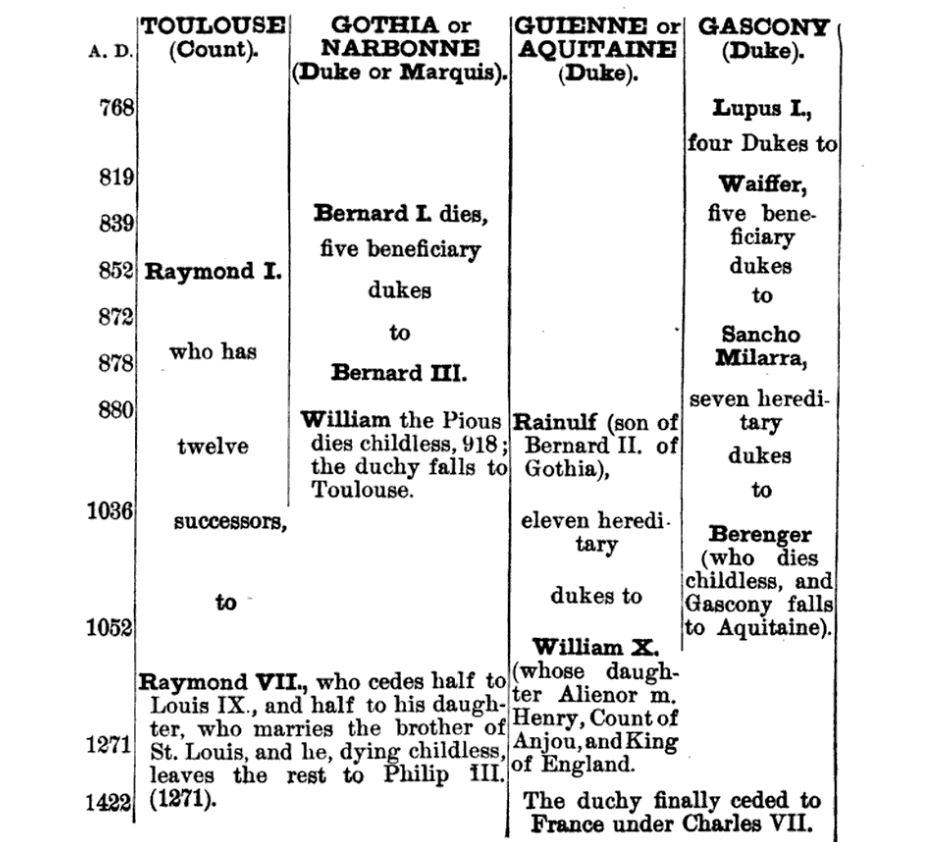
ОСТАННІЙ ФРАНЦУЗЬКИЙ ГОТИЧНИЙ КНЯЗЬ, ЯКИЙ ФУНКЦІОНАЛЬНО ВИКОРИСТОВАВ СІМЕЙНИЙ ТИТУЛ ГОТІЇ, ТИТУЛ, ЯКИЙ НАСЛІДИВ ОТ СВІЙШОГО ТА ДЕДЯ, “КНЯЗЬ ГОТІЇ” РАЙМОНД IV ТУЛУЗИ, БУЛ ЛІДЕРОМ ФУРЛУЗА.
Яку велику спадщину успадкували готи від Раймонда IV, наймогутнішого лідера Першого хрестового походу.
Він був правонаступником Королівського дому Готії як «принцепс Готія», а також графом Тулузи, герцогом Нарбоннським і маркграфом Провансу. Однак титул «Принц Готії» мав на видному місці його батько та дідусь, а також його прабабуся та дідусь протягом багатьох поколінь.
Після його перемоги, звільнивши Єрусалим та Візантію,
Раймонду була запропонована корона нового Єрусалимського королівства. Однак він відмовився, оскільки не хотів правити в місті, в якому страждав Ісус. Він сказав, що здригнувся, думаючи, що його називатимуть «королем Єрусалиму». Також цілком ймовірно, що він бажав продовжити облогу Тріполі, а не залишатися в Єрусалимі. Однак він також неохоче відмовився від Давидової вежі в Єрусалимі, яку він взяв після падіння міста, і лише з труднощами Годфрі Буйонський зміг забрати її у нього.
Раймонд брав участь у битві при Аскалоні незабаром після захоплення Єрусалима, під час якої вторгнення армії з Єгипту було розгромлено. Однак Раймонд хотів зайняти самого Аскалона, а не віддати його Годфрі, і в результаті суперечки Аскалон залишився незайнятим. Це було прийнято хрестоносцями лише в 1153. Годфрі також звинуватив його в невдачі своєї армії захопити Арсуф. Коли Раймонд пішов на північ, взимку 1099–1100 рр., Його першим актом було ворожнечу проти Богемонда, захопивши Лаодикію з Богемонда, повернувши її візантійцям.
ЦІ ДВІ РЯДКИ, ВІЗІГОТНІ І ОСТРОГОТИ, ОБ'ЄДНАЛИСЯ В OTTO IV, ГРЬЦОВИНІ БРЮНСВІКУ, ЯКИЙ КОРОНОВАНИЙ ІМПЕРАТОР СВЯТОЇ РИМСЬКОЇ ІМПЕРІЇ
Ці королівські лінії вестготів та остготів (династії Бельці та Амалі) знову були оновлені у герцога Оттона IV Брунсвікського, який був коронований імператором Священної Римської імперії як під французьким гербом Брансвік, так і над Аквітанією від матері (Матильда). Обидві сторони сім'ї її матері мали претензії на спадкоємство герцогства Тулуза (Готія). Цей герб Франції та Англії залишається і сьогодні в Брансвіку. Для більшості гілок Брансвіка його використовують як найстарішу версію з двома левами, а іноді і з одним левом. Хоча деякі гілки, в тому числі деякий час, Отто IV використовував версію трьох левів.
Слід зазначити, що його мати не тільки була суперницею Тулузської Готії, а й наступницею раннього засновника Будинку тамплієрів (Анжевін / Анжу). Протягом короткого періоду Отто IV був спадкоємцем засновника будинку тамплієрів, Анжевінської (Анжуйської) знаті Франції. Хоча сьогодні ніхто з французьких спадкоємців не залишається відомим з цієї родини, всі, крім Брансвіка. Однак будинок Брансвіка, але рідко нагадує Франції про ці права. Один на згадку згадувався під час війни з Наполеоном. Однак, як головнокомандувач союзних армій Пруссії, Австрії та Брансвіку, пропонувалася лише допомога справжньому французькому королю проти насильницького соціалізму Французької революції. Пропозиція головним чином полягала в тому, щоб захистити Його Високість від зловживань тощо, як це повинен запропонувати будь-який дійсний та справедливий суверен. Ця пропозиція знову була поширена на Наполеона III договором про допомогу Брансвіку в поверненні всіх німецьких земель під одну імперію.
Цей тамплієр Анжевін і Тулуза (вестготський) частково прийшов через дружину Генріха Лева Матильду. Однак набагато більше цього прийшло через власну спадкоємність Генріха будинку Біллунгів (остготів).
Як мати імператора Оттона IV ми визнаємо його, а решта його братів були спадкоємцями Анжевіна (Анжу), Аквітанії та всієї Франції. В Оттона IV було відроджено стільки заяв готиків, що його наступники ввели в закон використання титулу принца Геттінгена / Гутінгі. Ця додаткова французька гілка від його материнської спадщини ускладнила їх набагато далі за генеалогічні претензії Амелунга Біллінгса та гвельфську лінію до Арготти та найшанованішого Будинку готських імператорів.
МАЙКА ВСІХ ФРАНЦУЗЬКИХ КРАЛІВ, АРГОТТА І РАННЯ ГІЛЬФАНІЯ (БРЮНСВІКСЬКА СТАРША ФІЛІЯ)
The Frankish Kings absorbed and took over a major Gothian title for the part of France now known today as Langudoc. Many know prince Raymond IV of Gothia and Toulouse led the biggest armies of the 1st Crusade (and that he was equal peer of the King of France). Ever since the Frankish prince Alberici married Argotta, the daughter of Theodemir Amalaus King of Gothia, the sister of Theodoric Amali King of Gothia & Italy, and had a son Duke VAUBERTUS (or Wambertus) the title stuck and is in the official histories. Thus making him not only Heir of Gothia via his mother, but also the Grandson of the Sicambrian-Ukrainian descended Davidic King Pharamond on his father’s side (an established link in old Gothia Crimea where they still use the Gothic runes in their liturgy, it’s more similar to Greek letters). It’s also indisputed that the next in succession Gothian son Arnoldus founded the line of which Charlemagne is descended. The Guelphs (Brunswick House) is descended from the Grandaughter of Arnoldus, Princess Gertrude.
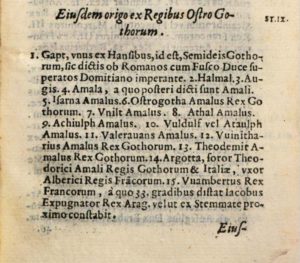
Ця генеалогічна ксерокопія взята з передруку 1628 року з Testamentum Magni, Regis Norvegiae, вперше написаного в 1277 році; - Judicium de scriptis Gasparis Scioppii contra Johannem Vosium et Famianum Stradam; –De variis febrium generibus; –Praelectiones poeticae, 1674; –Conclusiones et decreta Papae et Concilii Hispanici secreti, anno 1615 incepti, et usque ad annum 1627 perducti. Латинське. Хартацей, сек. xvii Quarto [11.247] (як це занесено в Британський музей).
Родовід, оскільки він стосується цих офіційних питань суверенітету багатьох держав, охоронявся як одна із найнадійніших відомостей, що існували. Союзні країни гарантували цю цілісність у війнах, щоб захистити такі права на спадкоємство тощо. Сьогодні у нас є деяке міжнародне право, яке все ще захищає наші уряди в еміграції, разом із кількома міжнародними договорами. Генеалогію можна взяти як одну з найбільш точних відомостей, що існують. Генеалогія Христа також є одним із прикладів, коли записи доступні і були використані для підтвердження суті. Тепер нам слід також, як це стосується християнської власності, і бути хорошим розпорядником того, що Він дав. «Генеалогії» Андерсона, опубліковані в 1732 році, широко визнані абсолютними. Як опубліковано нижче, ми знаходимо, що цей рядок повторює лінію Арготти від остготських королів та її шлюб з Альберічі, принцом франків. «Мати всіх французьких королів», яка є Арготтою, ми навіть у самому назві маємо цілу скарбницю підтвердження побожної спадкоємності. Будинок Брансвіка (гвельфи), що є цим раннім коренем. D'Este Guelph Brunswick-Wolfenbuettel-Oels, старший відділ,…
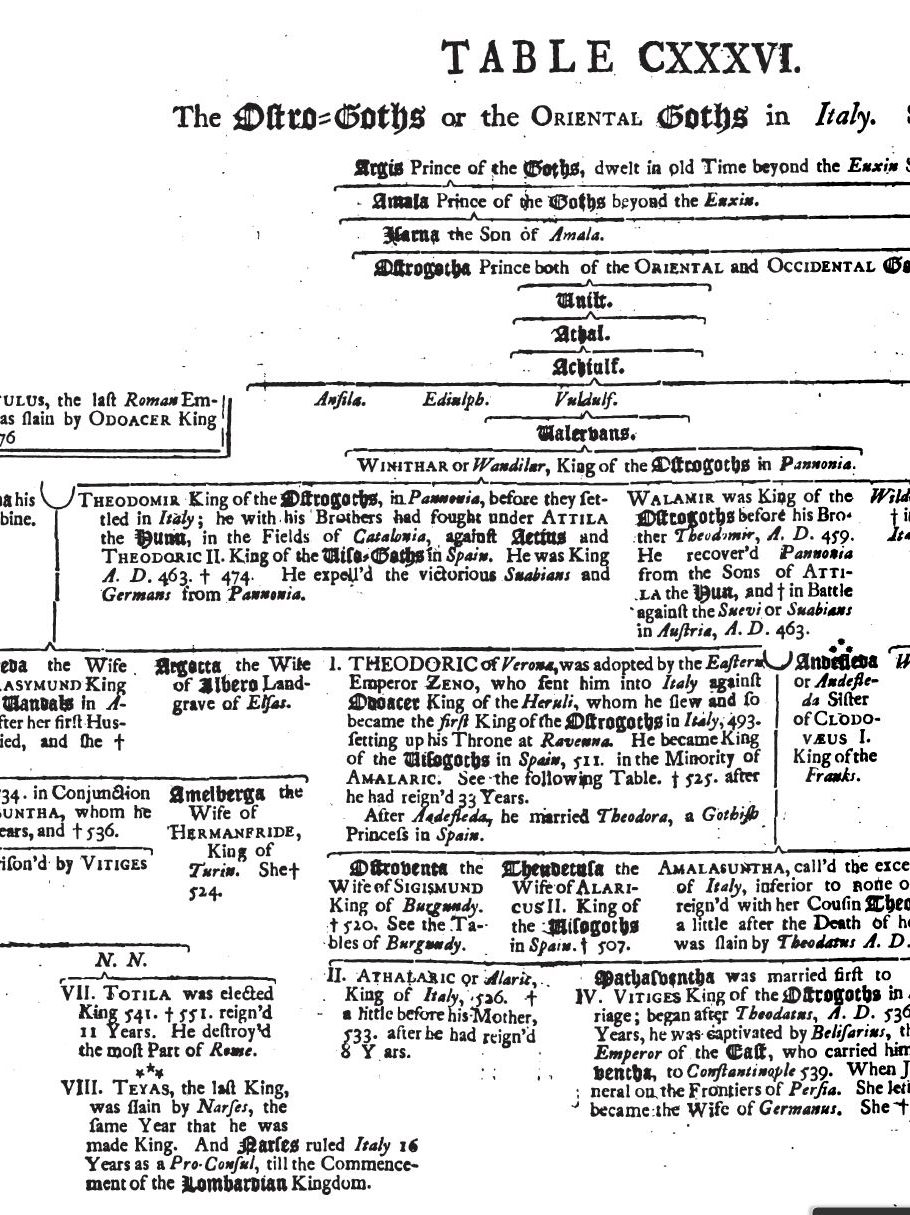
THE BALTI-GOTH DYNASTIC HEIRS
| Balti Goth Dynasty (Imp Gothia) |
| Theodoric I Balthas of Visigoths |
| Amalric
King of the Visigoths |
| Clodion, “le Chevelu”, King of France, son of Pharamond, King of France and Agotta, Queen, dau of Emperor Theodoric of Gothorum |
| Visigothic Princess Brunhilda + Sigebert I, King of Franks / Austrasia |
| Princess Chlodeswintha, dau of Sigebert & Brunhilda of Visigoths + Recaredo I King of the Visigoths |
| Bernardius Comte de Septimania, Margrave of Gothia, holding the independent allodial estates |
| Adalbertus, Duke of Alsatia (Alsace), son of Adalric, Duke of Alstatia, head of the Ethiconides, Major Domus of Allemania |
| Raymond IV, Prince of Gothia (Langudoc) Count of Toulouse, Provence and Narbone, peer/equal of the King of France. The head prince of the first Crusade, formed the earliest Knights Templar. |
| Matilda, Plantagenet & Angevin Princess of England, Normandy, Anjou, and Aquitaine, Head of Gothia Langudoc + Henry the Lion of Brunswick, Duke of Saxony and Bavaria |
| Emperor Otto IV, Duke of Brunswick, From 1196 was Duke of Aquitaine which covered most of France, incl Gothia / Langudoc, Was King Richard made him chief successor of the entire Angevin Empire(Britain, France, Jerusalem etc), withheld by the competing Capet line. 1197 crowned King of Germany, also King of Burgundy, Crowned Holy Roman Emperor 1206 |
| Emperor Frederick I Duke of Wolfenbüttel-Brunswick, Crowned King of Germany, Holy Roman Emperor |
| Wolfenbüttel Mini-Emperors. The ‘elder-branch’ Successors continually Emperors of states across the continent with continued Military rank higher than Emperor as Commander-in-Chief of Prussia, Austria, Poland, France, Senior branch over Hanover etc. Cont’d claim of estates linked with the “greater domains”. |
НАСЛІДЖЕННЯ ГОТІЇ І ІМПЕРСАЛЬНЕ НАСЛЯДЖЕННЯ
Цю тему не можна залишити, не згадуючи не лише титули готського принца, а й численні спадкові кров'яні спадщини імператорських маєтків останніх Імператорів кількох древніх ліній, що переходили до цього будинку.
Так багато маєтків імперських родин, що належали до аллоїдів, перейшли до єдиних спадкоємців чоловічої статі (Брансвік д'Есте-Гвельф). Це ще одне свідчення того, що це великий Божественний дар, як ми його завжди називаємо, “з Благодаті Божої”. У той самий час, коли Королівська династія Дому Готів була успішно передана, а спадщина Будинком Брансвік у Генріха Лева д'Есте-Гвельфа, була часом імператорської спадщини. Ці спадкоємства були не тільки з цього періоду, починаючи з 900 р. Н. Е. І закінчуючи 1200 р. За участю імператора Оттона IV Брансвікського, але вони продовжувались набагато далі.
У 1400 р. Імператором був обраний герцог Вольфенбюттель-Брансвік Фрідріх,
У 1600-х роках остання кровна лінія Піастів продовжувалась з Брансвіком,
У середині 1700-х років імператором всієї Росії став інший герцог Вольфенбюттель-Брансвік Іван VI.
Уже існувало стільки імперських ліній (жодна з яких родини Габсбургів чи Пруссії не може претендувати на нові будинки, оскільки їх кров була лише графами). Однак батьки та дідусі та бабусі Генріха Лева, які були Імператорами, і вони передали кровні права Імперії цій лінії, перш за все.
Хоча вже лінія мала право на найвищі королівства (тобто споконвічна велика Саксонія, герцогство з часів Генріха Лева та стародавніх Саксонських королів), вона часто утримувалася фактично імператорами. Імператор Лотар III (іноді його називають Лотаром II) з Суплінгенбурга надав тодішньому главі Палати (д'Есте-Гвельфа) Генріху Гордого повноваження щодо правонаступництва на посаду імператора. Імператорське правління Генріха 1137-38 було "від моря до моря, від Данії до Сицилії", як хвалився його єпископ Отто фон Фейзінг.
Видання імператора Лотара про спадкоємство Генріха також розширило його території, і воно включало передачу Імперських знаків розрізнення (Reichskleinodien).
Ця спадкоємність впродовж десятиліть була зрозумілою і була умовою всього правління Лотара для підтримки кількох провінційних герцогів Саксонії. Простежується, що ця підтримка навіть з моменту його обрання і до смерті була забезпечена лише одруженням єдиної дочки імператора з сином Генріха. У імператора Лотара була його єдина дитина, Гертруда, одружена з сином сина Генріха Чорного Генріхом Гордим. Без цього шлюбу численні герцоги доменів Генріха не визнали його власної імператорської спадщини.
From long before that time, up until today, the House of Brunswick has remained a the oldest living and most senior Imperial house of Germany(incl. beyond German borders), with an equal right to be elected to the throne of Emperor. This is of the original Reich of Charlemagne, under it’s laws which required unbiased voting for an Emperor that only holds that rank during war time. Afterwards is to go back as an equal prince. This mode was how Brunswick continued to operate, and was still often called to be commander-in-chief at times of great wars. The original order had been long usruped by the likes of the Hapsburgs and Prussians. From the inception of such illegal actions it has been met in the fields of battle and has continued even to this day, as shown in the existing treaty of Ham that the current head of House has rights to claim to exercise a right as Emperor of all German lands. The rights to all these estates have continued long since the Guelph and Ghibelline wars/rivalries, and the original stealing of 90% of the estate known as the Duchy of Saxony, of which is still contended for (from Eastphalia to Westphalia etc as the True Saxony borders) and is in the main coat of arms of the house (the coat of arms of the last King of Saxony). For much of the time this senior house has had wars with the current usurpers, Habsburg who have not done true valid elections, where all princes would have an equal chance to be Emperor. So the senior branch of (Wolfenbuettel)Brunswick refused to be electors, unlike the junior branch of (Hanover)Brunswick. Wolfenbuettel-Brunswick maintained seniority in the general college of princes. None of the college of princes nor the electors of the time would recognize Hanover’s illegal creation as a new elector(just to make more votes for Hapsburg, their only supporter). For much of the time till the destructions of Napoleon, the Brunswick’s held title of “Commander-in-Chief” over the entire Empire, a rank higher than the Kaiser in time of war. Multiple dukes held this title also during the war with Napoleon, as in previous centuries over the larger bodies of the Germanic nations. So in practice still the claim had remained somewhat recognized.
The Angevin territories (Britain, France and Jerusalem) were also inherited by the House of Brunswick, although has been in a rival dispute ongoing with the Capets. Several of the alloids of the House of Brunswick continue in the house as being older than the Carolingian Empire itself, still ongoing in a chief Imperial bloodline.
Brunswick-Gottingen (named after the Saxon King Witukind’s Danish wife and her line of Gothia Denmark-Sweden) was the allodial capital for the older Saxon Emperors of which the dukes of Brunswick descend. The transmission of the Imperial mantle continued from one Saxony duke to the next, Otto IV of Brunswick. Henry the Lion’s son, Otto IV von Brunswick also wore the Imperial insignia that was originally belonging to the house, when he was officially crowned Emperor, and recognized worldwide. There was one condition from the pope, that he would not retake the family’s possessions of Sicily. He broke that promise and for that reason was excommunicated, however the family from that day, till today has never abdicated this right and title of right to be Emperor, nor the titles that are most foundational of the Empire, as Europe’s oldest and most senior living Royal family (in legal international and prescriptive law).
ШВЕЦЬКО-ДАНСЬКИЙ ДІМ ГОТІЇ
Сьогодні (до 1972 р.) Правлячий будинок данців (будинок Глюксбурга) використовував титул короля готів.
Ця назва Готії сягає глибокої давнини. Усю територію там, Данію та Південну Швецію, називали Готією. Він також мав розпад власних Остготії та Вестготії тощо. Хоча ці кордони часто змінювались, все ще розуміли, що загальна назва регіону - Готія (і багато істориків писали Геатс, порівнюючи їх із Самогетією та племенами навколо Латвії та вниз у землі Біллунгера на захід (навколо Люнебурга).
The Swedish Goths and Danes were some of the greatest kindred allies of the House of Brunswick (especially loyal after Henry the Lion’s wars against various tyrannical German Emperors). Generation after generation of marriages continued with the Kiev Rus Vikings that were entertwined with the Danish Goth Royals.
One such marriage (Otto I the Child, to Princess Helena of the Danes) was contracted during the tumultuous period of the forced re-creation of Brunswick-Luneburg. Several gifts of the realm of Gothia were given from the King of Denmark to Otto. The re-creation of Brunswick however was accomplished by a trickery when Duke Otto the child, under duress was forced to “voluntarily” part with the Dynastic realms of Greater Saxony, of Italy, and the eastern Goth lands such as Pomerania where all would be returned back as one fief of the Empire. In 1235 he was forced to rename his vast domains into a re-consolidated Dukedom of Brunswick-Luneburg. Many have eroneously reported that this limited the domains of Brunswick. While it may appear limiting on it’s face, this was only as it stood within the Holy Roman Empire (HRE) jurisdiction, while Brunswick continued itself as an Empire across the continent. It was common that Dukedoms operated as the highest form of an Empire in parallel to the HRE, as other ducal Monarchies operated, such as the “Hapsburg Empire” with numerous subordinate principalities and other vassals. Hapsburg, like other houses of great Empires, had no higher rank than Dukes in the HRE (as dukes were higher than princes in German law). For Brunswick this claim was just as great, and arguably continued on greater than Austria in many respects. The post-1235 domains included several principalities, and succession rights in at far corners of the continent, with all states continuing their subordinations and loyalties as vassals of his house.
The Luneburg house (subordinent principality and alloid of the Dukedom) is most well known as a descendant branch of the House of Gothia. It is so visibly near to the region that is known to the name Gothaland, and holds the same coat of arms of that land as the primary shields of Brunswick-Luneburg.
The coat of arms for the Luneburg principality itself bears witness, with the design of the blue lion and hearts having it’s history as the main arms of Scandinavian Gothia, also while it was the primary house of the Kiev-Rus. Smaller provinces of Gothia would have less than 3 Swedish or Danish lions. We see this heraldry reflective in states also under subordination of Brunswick, such as Holstein, and from which the family descends in Schleswig and Glucksburg. This unmistakable symbol of the Gothis region of Scandinavia is the Blue Lion on the golden background, with the red hearts.
Genealogies tied to the arms are also most forthcoming within the house of Wolfenbuttel-Brunswick and it’s ancestors.
A major Gothian line of Brunswick goes back to Wulhild of Saxony, the daughter of Olaf II, King of Norway. Her mother was of the Royal House of Gothia. A chart has been put together as follows:
YNGLING-GOTH DYNASTY HEIRS
| Yngling Dynasty (Emperors/Kings of Scandinavian Gothenland) |
| Froda or Frey called Yngve |
| Gotharus Ottar Vendelkråka |
| Erik VIII the Victorius, King of Sweden
+Sigrid, Queen of all Gothenland, dau of Viking Skoglar Tosti (and Mother of Knut the Great) |
| Olaus Skötkonung
King of Gothia |
| Astrid Olofsdotter, Princess of Gothia
+ King Olaf II Harldsson of Norway Rex Perpetuus Norvegiae |
| Wulfhild of Gothia, Sweden and Norway + Ordulf Billung of Saxony |
| Emperor Henry the Proud of Brunswick, Ruled the Baltic to Sicily |
| William of Winchester, son of Henry the Lion. Brother of Emperor Otto IV, Duke of Brunswick, King of Germany, Crowned Holy Roman Emperor |
| Otto the Child, successor of Brunswick, in Denmark was made count of Garding and Thetesbüll in Schleswig Holstein as a Danish prince through his mother Helena Regent, princess and duchess + Ascanian Mechtild/Matilda of Brandenburg Ascanian Billunger Saxony |
| Emperor Frederick I Duke of Wolfenbüttel-Brunswick, Crowned King of Germany, Holy Roman Emperor |
| Wolfenbüttel Mini-Emperors. The ‘elder-branch’ Successors continually Emperors of states across the continent with continued Military rank higher than Emperor as Commander-in-Chief of Prussia, Austria, Poland, France, Senior branch over Hanover etc. Cont’d claim of estates linked with the “greater domains”. |
Otto the Child himself was descendant of this branch of Gothia, and of the Kiev Rus, and of the French Visigoth branches. Then his mother being the Danish princess gained him more rank in Gothia. He went in league with his uncle Valdemar II, King of Denmark. For his mutual support in war, Otto was made a Count of Schleswig (Sweden/Denmark Gothia).
Otto the Child’s mother was herself born into the Danish Royal house, long ruling the primary region of Gothia. Her father was King Valdemar I of Denmark, who was the son of Canute Lavard, Duke of Schleswig and his mother was Ingeborg of Kiev(daughter of Grand Prince Mstislav I of Kiev and Christina Ingesdotter of Sweden).
So the House of Brunswick also has this interesting Viking-Goth background of their ancestress, Helena of Denmark (a Duchess of Brunswick-Luneburg). Not only her paternal line was impressive, but also her maternal line: her mother was Sophia of Minsk, of the Rurikid Dynasty, as daughter of Volodar of Minsk and Richeza of Poland.
This is where half of the coat of arms of Wolfenbuttel-Brunswick comes from, the living Royal and Imperial House of Germany (cadet successor branch of 1935, a de jure house in exile).
ПОСТІЙНИЙ ЗАХИСТ КРИМСЬКОЇ ГОТІЇ
Можливо, один із найдавніших, проте один із найсвіжіших у використанні титулу "принц Готії" був у Криму. Слід зазначити, що гвельфи довгий час утримували благородних представників при дворі Готії в Каффі. Це було в періоди, коли Каффа входила до колоній Генуя, республіка Глефів.
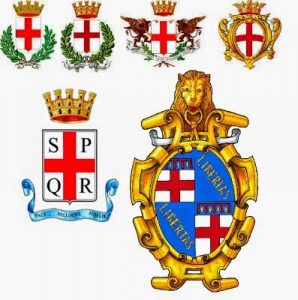
Геральдичний хрест elвельфів, що є червоним хрестом на білому тлі, був не лише гербом Генуї, але його можна знайти на громадянських гербах таких традиційно гвельфських міст, як Мілан, Верчеллі, Алессандрія, Падуя, Реджо та Болонья.
Деякі особи та сім'ї вказували свою приналежність до своїх фракцій у своєму гербі, включаючи відповідного начальника: у гвельфів був капо д'Ангіо або "начальник Анжу", золоті флерделі на блакитному полі з червоною геральдичною маркою "
Міські щити є свідком історії минулої боротьби між гвельфами (тамплієрами) та гібелінами (госпітальєрами). Кожен має зворотний щит хреста. Ці дві ворогуючі імператорські угруповання були головними суперниками імператорського престолу Священної Римської імперії.
Хоча різні папи оголосили майже десяток хрестових походів проти турків, особливо в Каффі, Крим, дуже мало хто прислухався до цього заклику. У книзі Хвалкова "Колонії Генуї в Причорномор'ї", сторінка 225, йдеться про те, що в Кафському єпископстві в Готії гвельфи вважалися дворянами і підтримували там благородного представника Гвельфа в Криму, але для Гібеліни (чи іншої венеціанської) він не згадує їх як благородних представників.
Сьогодні молодші кадетські відділення Есте мають перевагу в цій області Італії. Однак старшим відділенням Есте Гвельфа є Брансвік Вольфенбюттель. Це залишилось вічним позовом до будинку, визнаним усіма сторонами.
Цей же будинок подавав клопотання до посольства Росії та України про мирну угоду до того, як занадто багато кровопролиття було видано під час майдану та націоналістичних протестів у Києві в 2013-2014 роках. Оригінальна мирна пропозиція включала умови передачі Криму під контроль Будинку Нотт-Брансвік-Вольфенбюттель. У документі основна вимога українських виборчих прав полягала в тому, що сторона сім'ї Нотт має кілька рядків до оригінального засновника дворянства Київської Русі. Один із цих рядків був задокументований у листуванні.
Будинок Брансвіка також залишається пов'язаним із спадкоємством князів-єпископів Кримської Готії. Сюди входить теперішній архієпископ Готії в Криму та кілька їх єпархій.
+ Амвросій фон Сіверс, з Митрополія Готія є єпископом Справжньої православної церкви (Російської катакомбної церкви). Це наступна церква уникнула переслідувань більшовиків та їх наступних агентів. У деяких колах його церква розглядається як неканонічна, оскільки вона відмовляється підкорятися встановленій КДБ церкві. Оскільки єврейський єпископ, що втік, канонічно освятив + Амвросія, вважається, що церква готів справді канонічна на відміну від багатьох інших юрисдикцій. Однак переслідування тривали, оскільки протягом останніх двох поколінь на духовенство було здійснено напади та вбивства.
KIEV RUS GOTH DYNASTIC HEIRSHIP
|
||||||||||||||||||||||||||||||||||||
| Brunswick remained peer of Russia. co-protections remained with all Russian Monarchs. According to the primogeniture succession law 1797 re-established by Paul I of Russia, the Senior house of Wolfenbüttel-Brunswick are rightful heirs in Russian (and Dynastic, and international) law…
By numerous guarantees of Russian law, Russian Dynastic law, and Brunswick Dynastic law, and intl. treaties, these Russian estate titles of Romanov-Wolfenbuttel-Brunswick passed to the head duke of Brunswick in 1764. Charles I of Brunswick had multiple sons fighting against the illegal Russian regime in the wars that followed the murder of de jure and de facto Emperor Ivan VI von Wolfenbuttel-Brunswick in 1764. The last reigning de facto and de jure duke of Wolfenbuttel-Brunswick Charles II, was Nephew of the reigning Tsar of Russia. In multiple edicts placed death penalties on those who sought to divide his primogeniture hereditary estates, including those outside of mainland Europe. de jure princes of Wolfenbuttel Brunswick (from Ulric de Civry Wolfenbuttel forwards) include the cadet branch of the natural family that were not divorced from the natural family in edicts of Charles II. |
||||||||||||||||||||||||||||||||||||
ROYALTY OF HUNGARIAN GOTH ESTATES, AS PIAST & POLAND-LITHUANIAN SUCCESSORS
The Piast successor lines of Brunswick culminated also in the Royalty of Hungary who were the house of Angevin. The then successive rulers had claims in the realms of Transylvania, Wallachia, Moldova, and other original alloids of the Goth Nobility.
A senior Polish prince Vladislaus II had become King of Bohemia, and after having succeeded Matthias Corvinus in 1490, he also reigned as King of Hungary. Although King of Hungary, still Silesia and Moravia was retained in the hands and titles of the Corvinus family.
This line of Piasts, descendant of the Polish, Hungarian and Angevin Imperial lines, had passed down the succession of the house with the successors of Munsterberg, in Wurtemberg-Oels for Centuries. Finally when that (Württemberg) male line became extinct in 1792, it went as per the original Piast House law, that the Piast inheritance can pass by choice, and by female branches. So it passed to the last daughter and heiress Sophia Frederica Charlotte, to her husband, who upon his death passed it to his Heir, Duke Frederick William of Brunswick, from whence has continually been in the House of Brunswick-Wolfenbuettel which do this day maintains a valid status in international law as a de jure principality of the Brunswick-Wolfenbuettel-Oels government in exile.
This Silesian (and Griffin) Piast family name of Oels and coat of arms are continually used by the House of Wolfenbuttel-Brunswick, as the chief bloodline heirs of this branch. The heirship continued although there have been many occupations, including by Prussia. The occupations and usurpations have always been met with the strong legal protests, affirming the estates remain for the heirs pursuant to public, dynastic house law, treaty and international law.
The most Piast bloodlines, more than any other house culminated in the House of Wolfenbuttel-Brunswick. The only blood heir, and also the last Piast alloid principality in possession of any other monarch is known as “Oelsnica” (also the last residence of the sovereign Prussian Kaiser, during the occupation of Wolfenbuttel-Brunswick). It is retained with perpetual claim, and is used in the family name and coat of arms. Therefore several de jure sovereignty rights are preserved for Poland’s oldest Royal House and domains. The House of Wolfenbuttel-Brunswick (and by the House of Saxony) continues to maintain these basic requirements in international law.
One Piast line that founded the present bloodline of the House of Wolfenbuttel-Brunswick more here:
| Piast Imperial Dynasty (Silesian Piast Alloids and Ascanian Pomerania) |
| Bolesław I the Brave, King of Poland, Ruling Duke of Bohemia |
| Bolesław III Wrymouth Duke of Poland Silesian Piasts, Elder Branch of Piasts |
| Konrad I of Masovia, High Duke of Poland |
| Emperor Casimir III the Great, King of Poland, King of Russia |
| Emperor Louis I, King of Hungary and Croatia, King of Poland. House of Anjou(Father) and Piast (Mother) |
| Queen Jadwiga of Poland Piast – Anjou, Princess of Hungary, Grand Duchess of Lithuania, founding the Polish Lithuanian Monarchy |
| Philip II, Duke of Pomerania-Stettin (Griffin Piast and Wolfenbüttel) |
| Henry V of Wolfenbuttel, son of Henry IV and Griffin Piast Katerina of Pomerania
+ Sophia Jagiellon, Regent of Jerusalem, Duchess of Wolfenbüttel. |
| George IV William, last male of the “elder branch” Silesian Piasts |
| Clara Maria, Duchess of Pomerania, dau of Clara of Brunswick-Lüneburg, last Griffin Piast
Royal Marriage to Duke August II, of Wolfenbüttel, founder of senior branch Brunswick Wolfenbüttel |
HISTORICAL AND NEW DYNASTIC CHARTS OF THE HOUSE OF WOLFENBUTTEL-BRUNSWICK
A full chart of the Imperial lines of Dynastic succession (with several ongoing living estates and domains) is available. This presents what is supported in accepted international laws of recognition, in the family Dynastic laws concerned, in several aspects of international law and rules of prescription etc. More is available upon request by writing to marshalofsalem@yahoo.com or within the book now available on request from www.wolfenbuttel.info або www.vonbrunswick.com (copyright 2008-present).
The membership communities of the Gothian Empire have a strong cultural and ethnic basis whose people lost their right of self-determination and freedom of association for some time. The Priory of Salem, Institute of Peace Studies offers the support we have in Jesus Christ, who with the Father and the Holy Spirit helps this neglected people to find a higher sense of value, above that which the present world system offers. Our historic areas, our institutions, and aspects of our culture still bear their names of their Gothic origins today. The Bible tells us “look to the rock from whence you were hewn”. We find much encouragement as we trace the cultural heritage out to see God fulfiling the destiny of His covenant Christian people. Many of the surrounding studies of this House and parallel order, including our House Orders, and Templar Order, is found on our blogspot. The maps of the Gothia parallel Empire states is available on request, but much information is privileged for members only. A first step would be to fill in an application at https://St-AndrewsOCC.org and begin your mission to greater inner peace and satisfaction, through the encouragement of all God has provided to the body of Christ (His people) and their continuing order for their own people (religious, spiritual, priestly and royal).
PRINCE STEPHEN, ANOINTED AS A KING (of one jurisdiction of the many Goths’ states) OF THE GOTHS AT A BERLIN CEREMONY IN 2015
At a ceremony held by the Orthodox Church Western Rite Metropolia at Berlin, Stephen d’Guelph Brunswick was anointed as a titular King of the Goths(only one of many local Gothia jurisdictions), as an Emperor Elect, and as a Prince-Elector (an equal Elector on the Gothian Empire) high prince of his local jurisdiction (Benelux), at the formation and constitution signing for the re-founding of this order. http://gothiantemplar.blogspot.nl.
- House of Brunswick European Imperial Restoration Gains Popularity in Germany, France, Poland and Ukraine
- Brunswick Continuing Knights Templar House of the Original Angevin Royals’ branch, with full Royal protections of the Templar, incl. fons honorum
Other jurisdictions of the Goths also have (as demonstrated) had their own Kings of Goths at their local region. As Electors these titles may vary but are typically “Prince-Elector” and may hold dual local titles. In this case as a Brunswick heir of the local jurisdiction for the church which included various tribes, such as the Burgundian Goths. His forefather Otto IV von Brunswick was also King of Burgundy. So this title was most appropriately placed for this particular jurisdiction of Goths (at Benelux) and put into the founding charter documents co-signed by six other Imperial Electors. The election was set 10 years prior in official documents. The rank of Emperor can only become effective when there are twelve aethelings electing him (voting) for his rotation to head a true Germanic Imperial Diet. This is the ancient way which always ran parallel to the Holy Roman Empire.
Heirs of other Gothian States who can claim some form of de facto or de jure inheritance are also welcome to join our wider tribal order. The traditional and cultural representation of our Gothian States is in vital need of rekindling. The cultural representation in Brunswick, spanning more than 1,000 years is one valuable aspect of our order. The states include regions anywhere in the world where there is some kinship to the tribes of the Goths. As Brunswick has held a flag in most corners of the earth, including Australia, Canada, South Africa, etc, the tribe’s representation may be lacking. This ceremonial order for the local region may help booster morale and encourage more development of our cultural Christian civilization. The working together and having our own system and economy is important for our future success as a smaller tribal people.
The Templar of Gothia jurisdictions was then founded as an independent Order. Each Imperial Elector was automatically made a Grand Commander of their local jurisdiction. Gothia jurisdiction is not required to join the Templar but it is one of many options. Such as the Brunswick Order of Templar Portugal’s order etc. If it’s not with a Royal protector that has true sovereignty, then we can’t fully endorse them as knights, but would offer to integrate them into either order to gain this valuable level of Royal protection of international sovereignty within the Brunswick jurisdiction або Gothia jurisdiction.
militie templi iurisdictiones gothorum imperii
Knights Templar of Gothia. As established by the Prince of Gothia in 1099 under his kinsmen, the first 11 Angevin Kings of Jerusalem, and consecrated between hands of the Patriarchs of Constantinople and Jerusalem. Inherited by Wolfenbuttel-Brunswick, represented by Imperial Knights of Gothia, in allegiance to the Dynastic Heirs of the Angevin and Gothian House. With the aim to advance the Christian religion, restoring Jerusalem, and protecting our pilgrims as they worship at our holy sites.
ДОДАТОК
Оттонські імператорські печатки (застосовуються сьогодні в геральдиці Брансвіка)
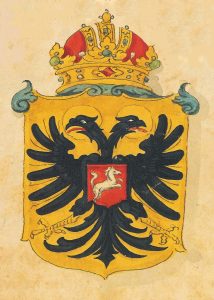

Печатки Отто IV з Брансвіка
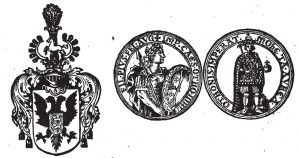
Герцог Отто Брансвікський, імператор Священної Римської імперії
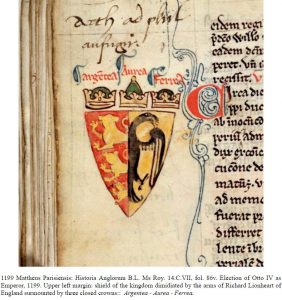
Російський імператор Іван VI Брансвік-Вольфенбюттель-Романов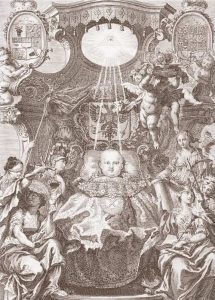
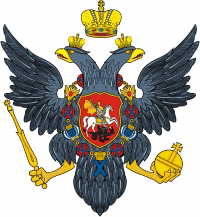
Інші статті на цю та сусідні теми доступні на celticorthodoxy.com
Praise YAHWEH every day for each victory as we do as Jesus Christ told us to pray, and to ordered us to “seek first His Kingdom law governance on earth”. May Jesus Christ soon come back to find us worthy to be His subjects, vassals, princely true Israel Nationalists, and thengs, at His Jerusalem government when He shall reign as King of kings and our Lord of lords.
This article is a mere sampling of the upcoming book to be made available at http://wolfenbuttel.info http://www.vonbrunswick.com (Copyright 2008 – Present).
Subscribers will have continued public service updates that include highly informational videos (now mostly for members only). You’ll learn how to get involved at local levels, as well as to vote and seek the self representation, self determination and freedom of association at is enshrined as a human right everywhere in the world (and is now the least claimed, but vitally important for future peace and prosperity).


